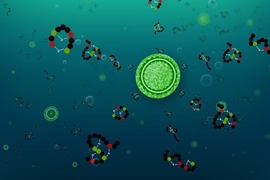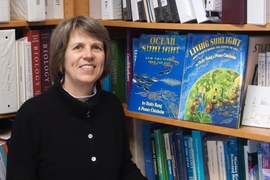MIT Institute Professor Sallie “Penny” Chisholm of the departments of Civil and Environmental Engineering and Biology is the recipient of the 2019 Crafoord Prize.
Announced on Jan. 17, Chisholm was awarded the prize “for the discovery and pioneering studies of the most abundant photosynthesizing organism on Earth, Prochlorococcus.”
Prochlorococcus is a type of phytoplankton found in the ocean that is able to photosynthesize like plants on land. The process of photosynthesis is responsible for the oxygen humans breathe, which makes it critical to life on Earth. Prochlorococcus accounts for approximately 10 percent of all ocean photosynthesis, which draws carbon dioxide out of the atmosphere, provides it with oxygen, and forms the base of the food chain.
While the organism is the most abundant photosynthesizer on the planet (the total amount of Prochlorococcus on Earth has been estimated to be 3*1027, or 3,000,000,000,000,000,000,000,000,000), it wasn’t until the mid-1980’s that Prochlorococcus was discovered by Chisholm and colleagues at the Woods Hole Oceanographic Institution. The reason the organism remained unknown for so long can be attributed to its small size. The tiny bacteria is half of a micrometer in size, 1/100 the width of a human hair, making it the smallest photosynthesizing organism.
Since its discovery, Chisholm and her team have found that although each cell has only 2,000 genes, the species as a whole has more than 80,000 different genes in its gene pool, which is four times more than the genetic makeup of humans. This vast diversity of genes distributed among the global population contributes to why Prochlorococcus is able to exist prominently in various environments containing different levels of light, heat, and nutrients.
Chisholm, who has been at MIT since 1976, now studies how Prochlorococcus interacts with various components of seawater and other microorganisms found in the ocean; its role in shaping the ocean ecosystem over evolutionary time; and how its populations may shift in response to climate change.
In April, Chisholm delivered a TED Talk that dove deeper into the properties of Prochlorococcus, comparing the organism’s genetic diversity to iPhone apps, and expanded on the the beauty of this microorganism as the smallest living thing that can convert solar energy and carbon dioxide into fuel through photosynthesis. Understanding its simple design could aid in efforts to engineer artificial photosynthesis machines — reducing our dependency on fossil fuels.
Prochlorococcus has even inspired Chisholm to educate future generations of scientists through a series of children’s books called the “Sunlight Series,” with co-author and illustrator Molly Bang. The series describes the Earth’s natural processes in layman’s terms and through imagery. While none of Chisholm’s books mention Prochlorococcus by name, Chisholm says the simplicity of Prochlorococcus compelled her to create the series.
Chisholm will present her prize lecture in Sweden at Lund University on May 13, and will receive her prize at the Royal Swedish Academy of Sciences prize award ceremony on May 15, in the presence of H. M. King Carl XVI Gustaf and H. M. Queen Silvia of Sweden.
The Crafoord Prize is awarded in partnership between the Royal Swedish Academy of Sciences and the Crafoord Foundation, with the academy responsible for selecting the Crafoord Laureates. Awards are presented in one of four disciplines each year: mathematics and astronomy, geosciences, biosciences, or polyarthritis (such as rheumatoid arthritis).









